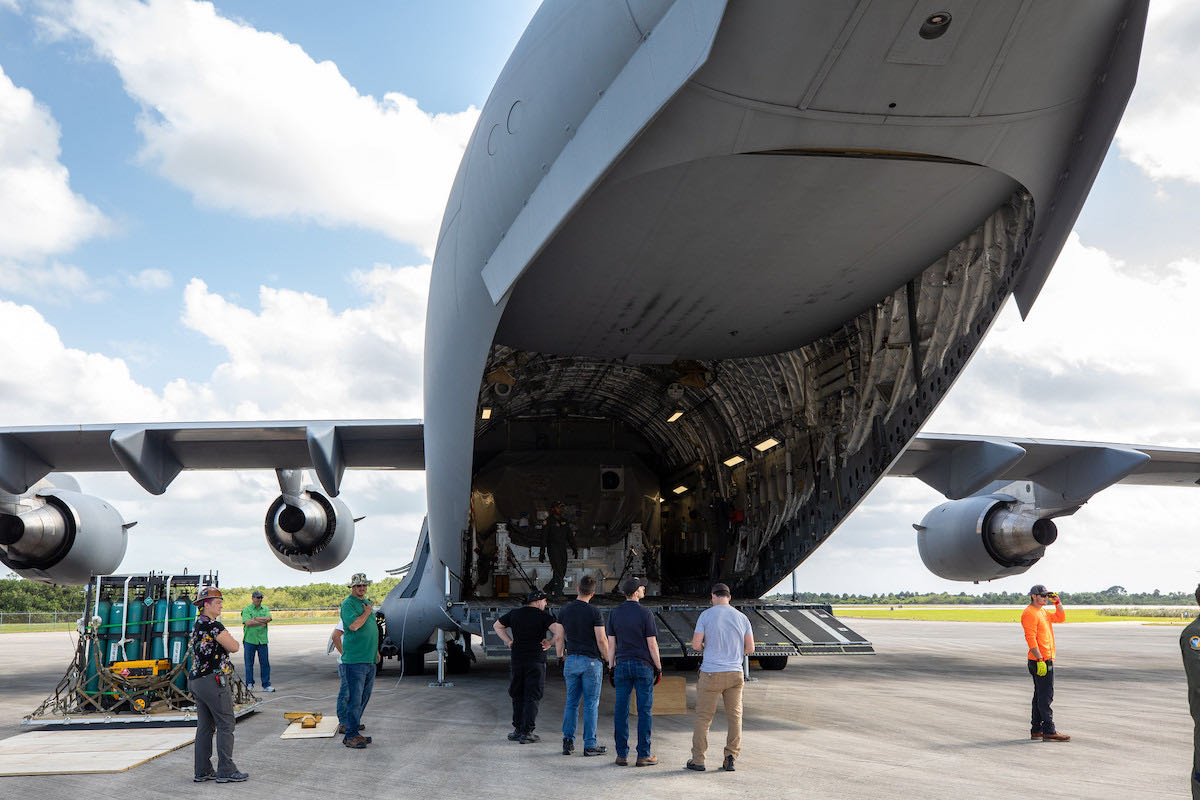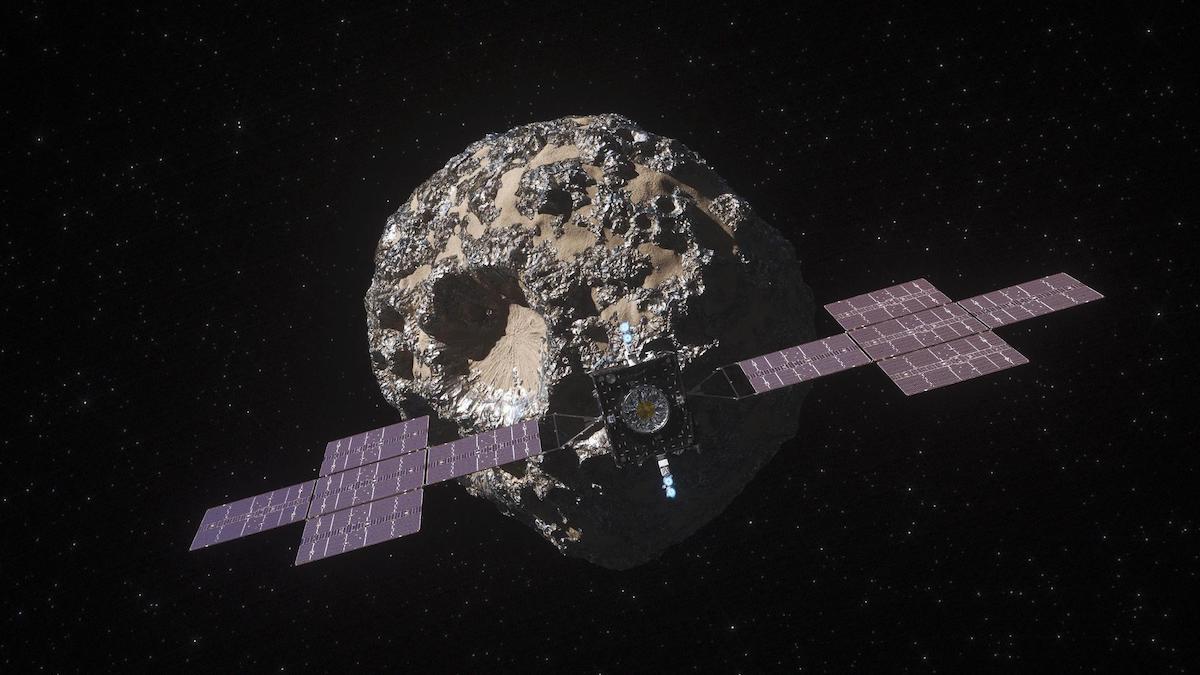
A U.S. military cargo plane delivered NASA’s Psyche spacecraft from California to the Kennedy Space Center last week, starting a three-month campaign to ready the asteroid explorer for liftoff on a SpaceX Falcon Heavy rocket in August.
The launch preparations at Kennedy will include loading of more than a ton of xenon gas into the Psyche spacecraft, followed by encapsulation of the probe inside SpaceX’s payload fairing before rolling out to pad 39A for integration with a Falcon Heavy launcher.
“Shipping to the launch site feels like the home stretch is kind of coming, and it certainly feels that way on Psyche,” said Brian Bone, the lead engineer on Psyche’s assembly, test, and launch operations team.
The xenon will fuel the spacecraft’s electric propulsion system, a set of four high-efficiency electric thrusters to guide Psyche from Earth to its namesake asteroid destination.
The robotic mission will reach the asteroid Psyche in January 2026, then enter a series of orbits at different distances to map the unexplored world. Psyche, the asteroid, has an irregular shape and has an average diameter of about 140 miles (226 kilometers). It is located between the orbits of Mars and Jupiter, and made mostly of nickel and iron metals.
The Psyche spacecraft’s launch period opens Aug. 1, with liftoff from pad 39A on that day timed for 2:26 p.m. EDT (1826 GMT). The launch will be the first flight of SpaceX’s powerful triple-core Falcon Heavy rocket for NASA.
The mission’s launch period extends several weeks, and is scheduled to allow the Psyche spacecraft to reach Mars in May 2023 for a flyby maneuver, using the planet’s gravity to slingshot toward the asteroid belt.
The delivery of the Psyche spacecraft to the Florida launch base follows months of testing at NASA’s Jet Propulsion Laboratory in Pasadena, California. The tests subjected the probe to the extreme cold temperatures and the airless environment of deep space, and ensured the spacecraft can withstand the shaking, acoustics, and shock forces it will encounter during launch.
With those tests complete, engineers placed the spacecraft in an environmentally controlled shipping container and drove it from JPL to March Air Reserve Base in Riverside, California, where a military flight crew loaded it into a C-17 transport plane for the cross-country journey to Florida.
After touching down at the Launch and Landing Facility at Kennedy Friday afternoon, Psyche was moved to the Payload Hazardous Servicing Facility, where engineers removed the spacecraft from its shipping crate earlier this week.
The transport of the Psyche spacecraft to Florida was “exceptionally smooth,” Bone said in an interview with Spaceflight Now.
Psyche was assembled and tested at JPL, and Maxar Technologies, a builder of commercial communications satellites, provided the spacecraft’s chassis, propulsion system, and solar panels. JPL, with extensive experience in deep space operations, provided Psyche’s flight computer, software, and parts of the communications and power systems.

One of the first tasks for the Psyche team will be testing to make the spacecraft was not damaged during shipment to Florida.
“In parallel the baseline testing, we’re doing alignments and making sure that nothing shifted or moved throughout the dynamics test campaign and the transit here to KSC,” Bone said.
The spacecraft processing team will also load new software on Psyche’s flight computer, and complete an end-to-end verification test with NASA’s Deep Space Network, which will track and communicate with the probe after launch.
Engineers will install the spacecraft’s power-generating solar panels, then fill Psyche’s seven xenon tanks with more than 2,200 pounds (1,000 kilograms) of fuel, Bone said. Nitrogen gas will also be loaded into the spacecraft for cold gas jets used for pointing, or attitude control.
The xenon gas will be loaded into the spacecraft over the course of about three weeks, beginning in early June, according to Bone. Xenon will fuel Psyche’s four plasma engines, which will combine electricity with xenon to produce low levels of thrust. Electric propulsion is more efficient than conventional rocket engines, requiring less fuel for large velocity changes — therefore, orbit adjustments — than other common spacecraft propellants, like hydrazine and nitrogen tetroxide, highly toxic but stable liquids that form a hypergolic mixture and ignite upon contact with one another.
Electric thrusters can run for weeks or months at a time, while less efficient, higher-thrust rocket engines fire for seconds or minutes.
There’s another benefit of electric propulsion from the perspective of the spacecraft processing team.
“It removes a huge hazard,” Bone said. “The biggest benefit is we just don’t have to worry about the hazardous operations of fueling with the hypergols. It’s easy. If there’s a leak, it’s inert. There’s not enough that it would be in an asphyxiant. We have a large volume area, so we’re in a very safe environment. So that just makes life tremendously easier.
“We can do other things on the spacecraft as we’re loading the propellant if we need to, minor things. There are no keep out zones. You don’t have to be specially trained. You don’t need medical certifications because you’re not using a SCAPE (Self Contained Atmospheric Protective Ensemble) suit.”
Teams at Kennedy will also install Psyche’s deep space transponder, part of its communications system, after it needed to be removed from the spacecraft at JPL for troubleshooting.
Two small spacecraft will hitch a ride to space with Psyche. NASA’s twin Janus probes, each weighing just 80 pounds (36 kilograms), will launch on the same Falcon Heavy rocket as Psyche, but will head off into the solar system to fly by separate asteroids.
The Janus smallsats are built by Lockheed Martin and should arrive at the Kennedy Space Center in late June for integration with an adapter ring connecting Psyche with its Falcon Heavy launcher. Then the entire spacecraft stack will be encapsulated inside the Falcon Heavy payload fairing inside the Payload Hazardous Servicing Facility.
SpaceX’s launch team, meanwhile, will connect the Falcon Heavy’s three first stage booster cores with the rocket’s upper stage. The rocket will go through a test-firing on pad 39A, then return to the hangar for connection with the Psyche and Janus spacecraft inside the payload shroud.

Psyche carries three scientific instruments: A pair of high-resolution color cameras for 3D images of the asteroid, a gamma ray and neutron spectrometer to measure the asteroid’s composition, and a magnetometer to measure the magnetic field of the asteroid.
The three-and-a-half year trip to asteroid Psyche will span 1.5 billion miles (2.4 billion kilometers), and the spacecraft is designed to spend at least 21 months studying the asteroid after arrival in 2026.
NASA selected Psyche as a Discovery-class interplanetary mission in 2017, alongside the Lucy asteroid explorer, which launched last year. The Psyche mission’s total cost is nearly $1 billion, including development, launch services, and operations.
Supply chain difficulties and the COVID-19 pandemic added pressure to Psyche’s development team to keep the mission on track for launch this year.
“It just made things drag out longer, made things show up at times when they were maybe not optimal for the schedule,” Bone said. “So we did a lot of reworking and a lot of rescheduling and a lot of finding opportunities to test items on second shifts, to make sure we kept our schedule intact, and we were very successful in doing that.”
Email the author.
Follow Stephen Clark on Twitter: @StephenClark1.
from Spaceflight Now https://ift.tt/31bfCvk
via World Space Info







0 comments:
Post a Comment